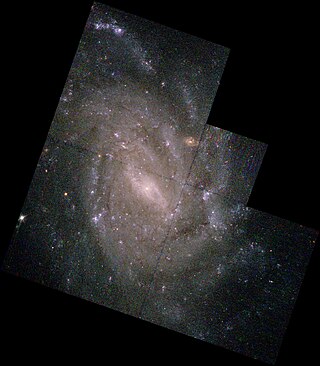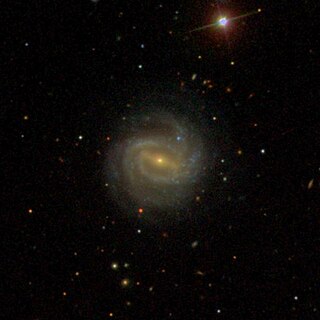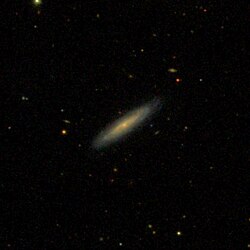
NGC 5334 is a face-on barred spiral galaxy in the constellation Virgo. Its velocity with respect to the cosmic microwave background is 1668 ± 20 km/s, which corresponds to a Hubble distance of 80.2 ± 5.7 Mly (24.60 ± 1.75 Mpc). However, five non-redshift measurements give a distance of 108.68 ± 7.45 Mly (33.320 ± 2.283 Mpc). It was discovered by German-British astronomer William Herschel on 15 April 1787. It was also observed by American astronomer Lewis Swift on 20 April 1897 and listed in the Index Catalogue as IC 4338.

NGC 5490 is a large elliptical galaxy located in the constellation of Boötes. Its velocity relative to the cosmic microwave background is 5,075 ± 22 km/s, which corresponds to a Hubble distance of 244.1 ± 17.1 Mly (74.85 ± 5.25 Mpc). In addition, 13 non-redshift measurements gives a distance of 269.98 ± 15.01 Mly (82.777 ± 4.603 Mpc). NGC 5490 was discovered by the German-British astronomer William Herschel on 14 March 1784.

NGC 5754 is a barred spiral galaxy located 218 million light years away in the constellation Boötes. It was discovered by German-British astronomer William Herschel on 16 May 1787.

NGC 7714 is a spiral galaxy in the constellation Pisces. Its velocity with respect to the cosmic microwave background is 2430 ± 26 km/s, which corresponds to a Hubble distance of 116.9 ± 8.3 Mly (35.85 ± 2.54 Mpc). In addition, five non-redshift measurements give a distance of 92.24 ± 8.69 Mly (28.280 ± 2.664 Mpc). It was discovered by British astronomer John Herschel on 18 September 1830.

NGC 4790 is a barred spiral galaxy located in the constellation of Virgo. Its velocity with respect to the cosmic microwave background is 1679 ± 24 km/s, which corresponds to a Hubble distance of 80.8 ± 5.8 Mly (24.76 ± 1.77 Mpc). In addition, six non-redshift measurements give a distance of 74.75 ± 4.07 Mly (22.917 ± 1.249 Mpc). It was discovered on 25 March 1786 by German-British astronomer William Herschel.

NGC 681 is an intermediate spiral galaxy in the constellation of Cetus, located approximately 66.5 million light-years from Earth.

NGC 2300 is a lenticular galaxy in the constellation Cepheus. Its velocity with respect to the cosmic microwave background is 1876 ± 7 km/s, which corresponds to a Hubble distance of 90.2 ± 6.3 Mly (27.67 ± 1.94 Mpc). However, 11 non redshift measurements give a distance of 131.98 ± 21.75 Mly (40.464 ± 6.668 Mpc). The galaxy was discovered in 1871 by French astronomer Alphonse Borrelly using an 18 cm telescope.

NGC 1332 is an almost edge-on elliptical galaxy located in constellation of Eridanus. Situated about 70 million light years away, it is a member of the Eridanus cluster of galaxies, a cluster of about 200 galaxies. It is also the brightest member of the NGC 1332 Group. It was discovered by William Herschel on 9 December 1784.

NGC 3254 is a spiral galaxy in the constellation Leo Minor. It was discovered on March 13, 1785, by the astronomer William Herschel. It is a member of the NGC 3254 Group of galaxies, which is a member of the Leo II Groups, a series of galaxies and galaxy clusters strung out from the right edge of the Virgo Supercluster.

NGC 5004 is a lenticular galaxy in the constellation Coma Berenices. The object was discovered by astronomer William Herschel on 13 March 1785, using an 18.7-inch aperture reflector telescope. Due to its moderate apparent magnitude (+13), it is visible only with amateur telescopes or with superior equipment.

NGC 1585 is a spiral galaxy in the constellation of Caelum. Its velocity with respect to the cosmic microwave background is 4,635 ± 31 km/s, which corresponds to a Hubble distance of 68.4 ± 4.8 Mpc. It was discovered by British astronomer John Herschel on 1 December 1837.

NGC 662 is a spiral galaxy in the constellation of Andromeda. Its velocity with respect to the cosmic microwave background is 5,397 ± 18 km/s, which corresponds to a Hubble distance of 79.6 ± 5.6 Mpc. It was discovered by French astronomer Édouard Stephan on 22 November 1884.

NGC 6008 is a barred spiral galaxy in the constellation of Serpens. Its velocity with respect to the cosmic microwave background is 4,959 ± 8 km/s, which corresponds to a Hubble distance of 73.2 ± 5.1 Mpc. It was discovered by French astronomer Édouard Stephan on 10 June 1880.

NGC 2708 is a spiral galaxy in the constellation of Hydra. Its velocity with respect to the cosmic microwave background is 2315 ± 22 km/s, which corresponds to a Hubble distance of 34.15 ± 2.41 Mpc. It was discovered by German-British astronomer William Herschel on 6 January 1785. This galaxy was also observed by British astronomer John Herschel on 12 March 1826, and later listed as NGC 2727.

NGC 2804 is a lenticular galaxy in the constellation of Cancer. Its velocity with respect to the cosmic microwave background is 8580 ± 20 km/s, which corresponds to a Hubble distance of 126.55 ± 8.86 Mpc. It was discovered by British astronomer John Herschel on 24 February 1827. This galaxy was also observed by the French astronomer Stéphane Javelle on 9 April 1896, and was later added to the Index Catalogue as IC 2455.

NGC 5876 is a barred spiral galaxy in the constellation of Boötes. Its velocity with respect to the cosmic microwave background is 3325 ± 5 km/s, which corresponds to a Hubble distance of 49.05 ± 3.43 Mpc. However, three non redshift measurements give a distance of 65.6 ± 0.346 Mpc. The galaxy was discovered by American astronomer Lewis Swift on 11 June 1885. Swift observed the galaxy again on August 27, 1888, and not realizing that he had already observed it, entered the galaxy into the Index Catalogue as IC 1111.

NGC 5162 is a very large spiral galaxy in the constellation of Virgo. Its velocity with respect to the cosmic microwave background is 7125 ± 20 km/s, which corresponds to a Hubble distance of 342.8 ± 24.0 Mly (105.09 ± 7.36 Mpc). In addition, 11 non redshift measurements give a distance of 303.71 ± 12.41 Mly (93.118 ± 3.806 Mpc). The galaxy was discovered by German-British astronomer William Herschel on 15 March 1784. It was also observed by Lewis Swift on 19 April 1887, resulting in the galaxy being included twice in the New General Catalogue, as both NGC 5162 and NGC 5174.

NGC 6492 is a spiral galaxy in the constellation of Pavo. Its velocity with respect to the cosmic microwave background is 4351 ± 8 km/s, which corresponds to a Hubble distance of 209.3 ± 14.6 Mly (64.17 ± 4.49 Mpc). In addition, five non redshift measurements give a distance of 183.10 ± 12.28 Mly (56.140 ± 3.766 Mpc). The galaxy was discovered by British astronomer John Herschel on 22 July 1835.

NGC 4246 is a spiral galaxy in the constellation of Virgo. Its velocity with respect to the cosmic microwave background is 4064 ± 24 km/s, which corresponds to a Hubble distance of 195.5 ± 13.7 Mly (59.94 ± 4.21 Mpc). However, 20 non-redshift measurements give a distance of 172.01 ± 10.57 Mly (52.740 ± 3.241 Mpc). It was discovered by German-British astronomer William Herschel on 13 April 1784. It was also observed by German astronomer Arnold Schwassmann on 30 October 1899 and listed in the Index Catalogue as IC 3113.

NGC 4495 is a spiral galaxy in the constellation of Coma Berenices. Its velocity with respect to the cosmic microwave background is 4850 ± 20 km/s, which corresponds to a Hubble distance of 233.3 ± 16.4 Mly (71.54 ± 5.02 Mpc). Additionally, 31 non-redshift measurements give a distance of 223.50 ± 3.58 Mly (68.526 ± 1.099 Mpc). It was discovered by German-British astronomer William Herschel on 13 March 1785.




















